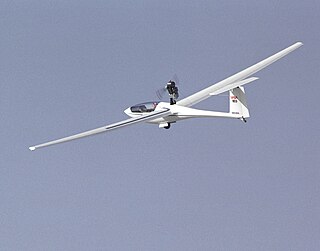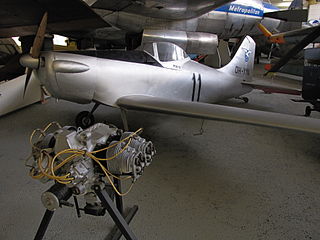
The Rolladen-Schneider LS7 is a high-performance Standard Class single-seat sailplane produced by Rolladen-Schneider Flugzeugbau GmbH from 1988 to 1993.

The LS11 or AFK1 is a prototype Two-Seater Class sailplane currently in development at Akaflieg Köln e.V.. The LS11 first flew on 5 November 2005.

The Rolladen-Schneider LSD Ornith is the first two-seater sailplane to have been built from plastic composites. The single exemplar was designed by Wolf Lemke and Karl Pummer and first flew in May 1972, a few weeks before the Akaflieg Braunschweig SB-10 Schirokko.

The PIK-20 sailplane was designed at the Helsinki University of Technology by Pekka Tammi, with advice from Ilkka Rantasalo and Raimo Nurminen. The prototype first flew on 10 October 1973. It was produced initially by Molino Oy who were taken over by Eiri-Avion Oy between 1974 and 1980. Later, production was taken over by the French company, Siren SA, under the name Siren PIK-20.

The Valmet PIK-23 Towmaster or Suhinu is a Finnish two-seater glider-towing/primary trainer aircraft built entirely out of composite materials in the early 1980s.

The Schneider Grunau Baby was a single-seat sailplane first built in Germany in 1931, with some 6,000 examples constructed in some 20 countries. It was relatively easy to build from plans, it flew well, and the aircraft was strong enough to handle mild aerobatics and the occasional hard landing. When the Baby first appeared, it was accepted wisdom that the pilot should feel as much unimpeded airflow as possible, to better sense rising and falling currents of air and temperature changes etc.

The Grob G 103 Twin Astir is a glass-reinforced plastic two-seat sailplane that was developed in Germany in the 1970s by Grob Aircraft AG as a counterpart to the single-seat G 102 Astir, then in production. Construction throughout is similar, although to preserve the centre of gravity of the design, the wings were given a slight forward sweep. While many two-seat derivatives of single-seat sailplanes have fixed undercarriage, due to the added space restrictions created by the second seat, Grob devised a novel retraction system for the Twin Astir. The single wheel was designed to rotate 90° sideways before retracting "flat" under the rear seat, resulting in a rather unusual seating position. This was only incorporated in early examples, later on, the wheel was fixed. Factory options offered to customers included whether the front seat should be equipped with flight instruments, and whether water ballast capacity should be installed.
The Slingsby T.9 King Kite is a British glider designed and built by Slingsby that first flew in 1937.
The PIK-3 was a sailplane produced in Finland in the 1950s and 60s. It was designed to be a cheap and easy-to-build aircraft to equip the country's gliding clubs as their standard single-seat machine. It was a conventional design for its day, with a high wing and conventional empennage. Construction was of wood throughout, skinned in plywood.

The PIK-5 was a training glider produced in Finland in the 1940s, and 1950s, equipping the country's gliding clubs with an aircraft greater in performance than primary gliders but less than competition sailplanes.

The Harakka was a primary glider produced for pilot training in Finland in the 1940s. Its design was typical of this class of aircraft, a "keel" with a pilot's seat suspended beneath a high, strut-braced monoplane wing, and carrying a conventional empennage at the end of an open framework. First flown in February 1945, the type was built from plans by Finnish gliding clubs and soon replaced earlier primary gliders such as the Grunau 9, becoming a standard piece of equipment in the clubs.

The PIK-11 Tumppu ("Mitten") was a single-seat, single-engine sport aircraft developed in Finland in the 1950s. It was a low-wing, cantilever monoplane of conventional design with an enclosed cockpit and fixed, tailwheel undercarriage. It was to be the first powered aircraft produced by Polyteknikkojen Ilmailukerho, with the objective being building an aircraft for club use that was cheap to build and easy to fly.
The PIK-19 Muhinu was a light aircraft developed in Finland in the early 1970s for use as a glider tug and flight trainer. It was a low-wing cantilever monoplane of conventional configuration, with an enclosed cockpit and fixed, tricycle undercarriage. Its construction was of composite materials throughout, a novel approach at the time. When the PIK-19 flew for the first time in 1972, it was only the fourth aircraft in the world made of these materials.

The Scheibe Bergfalke is a German glider designed by Egon Scheibe as a post-World War II development of the Akaflieg München Mü13 produced before and during the war.
Akaflieg Darmstadt is one of approximately twenty aviation groups attached to German universities. Akaflieg is an abbreviation for Akademische Fliegergruppe, an academic group of students and faculty from a German University.

The Slingsby T.59 Kestrel is a British Open class glider which first flew in August 1970. Of fibreglass construction, it features camber-changing flaps, airbrakes, and a retractable main wheel.

The Lehtovaara PIK-16 Vasama is a Finnish mid-wing, single-seat, FAI Standard Class glider that was designed by Tuomo Tervo, Jorma Jalkanen and Kurt Hedstrom, who were students at the Polyteknikkojen Ilmailukerho (PIK) and produced by Lehtovaara.
Egon Scheibe was a German aviation engineer who, among other things, developed the Scheibe Bergfalke glider.














